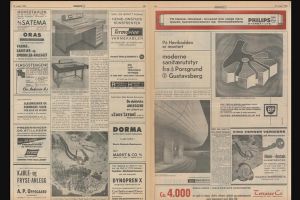
Caroline Ugelstad
Project Partner
Caroline Ugelstad is head curator at Sonja Onstad Art Centre, Høvikodden, outside of Oslo.
Architecture Past and Future in the Era of Circularity

Caroline Ugelstad is head curator at Sonja Onstad Art Centre, Høvikodden, outside of Oslo.

This exhibition explores the full material provenance of the Henie Onstad Art Centre (HOK), including building materials, technical infrastructure, furniture, display systems, lighting fixtures, maintenance systems and more.
By thorough investigation of the archives, and through on-site survey of the building, nine students and two teachers from the Oslo School of Architecture and Design (AHO) have excavated the ownership history, production history, economy, sourcing, usage and alteration records of its components and materials. By constructing an alternative history of the building, this exhibition challenges the way we understand and assess buildings - and might change the way we transform them for the future.
Henie Onstad Art Centre is designed by the young Norwegian architects Jon Eikvar and Svein-Erik Engebretsen and was inaugurated August 23rd, 1968. It was radical of its time, both in terms of the curatorial ideas and the innovative architecture. Initiated and funded by the figure skater and Hollywood movie star Sonia Henie and her husband, the shipowner Niels Onstad, HOK represented a state-of-the-art cultural institution much inspired by Moderna Museet, Stedelijk Museum and Louisiana Museum of Modern Art. Based on the personal relationships of HOK’s director Ole Henrik Moe with people like Pontus Hultén, Willem Sandberg and Knut W. Jensen, the new center aimed for a new definition of art, showcasing contemporary music, dance, performance, film and photography alongside paintings, drawings and sculpture - engaging its visitors in new ways.
Eikvar and Engebretsen, recent graduates from Statens Arkitektkurs at Statens Håndverk- og Kunstindustriskole and employees at Nils Holter’s studio, won the competition in 1965 with an innovative scheme influenced by ideas that was circulating at the time. The project development and the building process progressed in line with the radical museum concept, including experimentation with new materials, 1:1 mock-ups, «electronic» site-management and more. Since 1968, the building had been expanded, altered and restored several times, and the art center has gained reputation as one of the leading art institutions in Scandinavia.
This seminar explores the full material provenance of the Henie Onstad Art Centre (HOK), located at Høvikodden in Bærum, including building materials, technical infrastructure, furniture, display systems, lighting, maintenance systems, as well as the thousands of art works that has been on display across the decades. By thorough investigations of the archives at HOK and at other locations, and through on-site surveys of the building, the students will excavate the sourcing, ownership history, production history, economy, usage and alteration records of the components, materials and artworks. By constructing an alternative history of the building,this seminar challenges the way we understand and value-assess buildings, and might change the way we transform them for the future. In addition, the seminar aims to provide scenarios for HOKs future development.
Henie Onstad Art Centre was inaugurated in 1968 and designed by the young architects Jon Eikvar and Svein-Erik Engebretsen. It was radical of its time, both in terms of its curatorial ideas and its innovative architecture. Initiated and funded by the figure skater and Hollywood movie star Sonia Henie and her husband, the shipowner Niels Onstad, HOK represented a state-of-the-art cultural institution much inspired by Moderna Museet in Stockholm, Stedelijk Museum Amsterdam and Louisiana Museum of Modern Art outside of Copenhagen. Based on the personal relationships of HOK’s director Ole Henrik Moe with people like Pontus Hultén, Willem Sandberg and Knut W. Jensen, the new center aimed for a new definition of art, showcasing contemporary music, dance, performance, film and photography alongside paintings, drawings and sculpture, engaging its visitors in new ways. Eikvar and Engebretsen, recent graduates from Statens Arkitektkurs at Statens Håndverk- og Kunstindustriskole (later Oslo School of Architecture) and employees at Nils Holter’s studio, won the competition in 1965 with an innovative scheme influenced by ideas that was circulating at the time. The project development and the building process progressed in line with the radical museum concept, including experimentation with new materials, 1:1 mock-ups, «electronic» site-management and more. Since 1968, the building had been expanded, altered and restored several times, and the art center has gained reputation as one of the leading art institutions in Scandinavia.